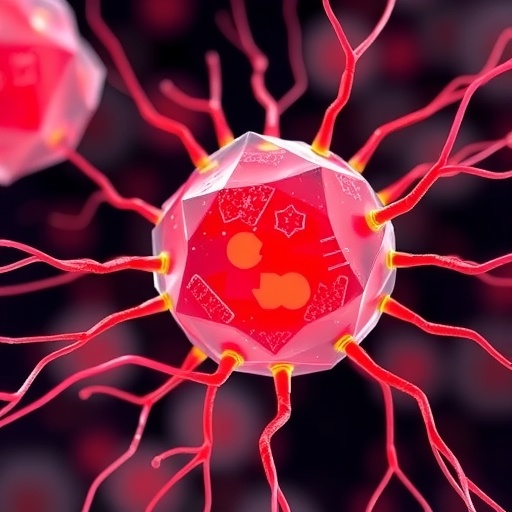In a groundbreaking exploration into the molecular landscapes of breast cancer, researchers have unveiled compelling evidence that collagen type VI alpha 6 chain (COL6A6) acts as a significant tumor suppressor, intricately linked to immune regulation within the tumor microenvironment. This revelation, deriving from an extensive series of experiments and analyses, opens new avenues for therapeutic intervention and prognostic evaluation in breast cancer, a disease that continues to impose a heavy global health burden.
COL6A6, a critical component of the epithelial cell basal lamina, was previously recognized for its structural role in tissue integrity. However, its suppressive function in tumorigenesis had remained elusive until recently. The study, appearing in the highly respected journal BMC Cancer, meticulously dissects the expression patterns of COL6A6 across thousands of breast cancer specimens and non-cancerous tissues, revealing a consistent and stark downregulation in malignant samples. This downregulation correlates strongly with poorer clinical outcomes, suggesting that COL6A6’s presence—or absence—may influence disease progression profoundly.
To unravel the complex interplay between COL6A6 and the immune microenvironment integral to breast cancer, the researchers employed a multifaceted methodological approach. Initial immunohistochemical staining of breast cancer tissues alongside controls unveiled significantly diminished COL6A6 protein abundance in cancerous tissues. Complementary analyses of global microarray and high-throughput sequencing datasets reinforced these findings, illuminating a wider pattern of COL6A6 mRNA downregulation with striking statistical robustness across diverse patient cohorts.
.adsslot_RbHpQqCIZV{width:728px !important;height:90px !important;}
@media(max-width:1199px){ .adsslot_RbHpQqCIZV{width:468px !important;height:60px !important;}
}
@media(max-width:767px){ .adsslot_RbHpQqCIZV{width:320px !important;height:50px !important;}
}
ADVERTISEMENT
The integration of single-cell RNA sequencing enabled an unprecedented resolution in mapping COL6A6 expression at the cellular level, demonstrating that reductions were not merely a population-wide phenomenon but localized within specific cell types pivotal to tumor structure and immunity. This granular insight highlighted the gene’s potential influence over the spatial and functional dynamics of immune cell infiltration within tumors, which is a critical determinant of tumor behavior and therapeutic responsiveness.
Crucially, the prognostic power of COL6A6 expression was substantiated through Kaplan–Meier survival analyses encompassing a large multicenter breast cancer cohort. Patients exhibiting lower COL6A6 levels experienced significantly diminished overall survival and relapse-free survival, reinforcing the marker’s clinical relevance. Decision curve analyses further emphasized its potential utility in guiding treatment decisions and patient stratification, a promising leap toward personalized oncology.
Delving deeper into the tumor immune microenvironment, the study utilized sophisticated tumor deconvolution techniques to dissect the cellular composition of breast cancer tissues. Findings revealed a negative correlation between COL6A6 expression and tumor purity, with a concurrent positive correlation with stromal and immune cell abundance. This suggests that COL6A6 downregulation may facilitate a tumor milieu less infiltrated by immune effector cells, thereby potentially enabling immune evasion and tumor progression.
Gene set enrichment analyses provided compelling evidence that COL6A6 associates with immune pathways critical to antitumor responses, including adaptive immunity, T cell differentiation, macrophage activation, and natural killer (NK) cell cytotoxicity. These immune-related pathways are essential for recognizing and eliminating tumor cells, underscoring the functional implications of COL6A6 in sustaining a robust anti-cancer immune environment.
The investigation extended into in vivo mouse models, wherein immunization with a COL6A6-derived peptide vaccine evoked significant enrichment of immune activation processes such as immunoglobulin production, myeloid leukocyte activation, leukocyte chemotaxis, and neutrophil migration. These results demonstrate that COL6A6 can actively modulate diverse immune populations, reinforcing its role in immune system engagement against breast cancer.
Spatial transcriptomic sequencing further illuminated the landscape of immune cell distribution in relation to COL6A6 expression in malignant breast tissue slices. Notably, areas exhibiting decreased COL6A6 showed reduced infiltration of immune cells, substantiating the hypothesis that COL6A6 supports immune surveillance mechanisms within tumors. This spatial association affirms the intricate connection between extracellular matrix components and immune cell trafficking in the tumor microenvironment.
At the transcriptional regulatory level, the study identified the CBX2 transcription factor as a potential repressor of COL6A6 expression, providing a mechanistic hypothesis for its downregulation in breast cancer. This regulatory insight opens possibilities for targeting transcriptional pathways to restore COL6A6 expression and reinvigorate antitumor immunity.
Taken together, these data position COL6A6 not only as a biomarker for prognosis but also as a pivotal factor in the immune architecture of breast cancer. Its downregulation correlates with tumor immune escape, while its presence supports immune activation, highlighting a novel dimension of tumor-host interactions mediated by extracellular matrix components. This convergence of structural biology and immuno-oncology heralds a paradigm shift in understanding breast cancer pathophysiology.
The implications extend beyond the clinic, challenging prevailing notions of tumor microenvironment regulation and inviting new research into collagen family proteins as active participants in cancer immunity. Future studies may elucidate whether restoration of COL6A6 expression or activity can reprogram the immune landscape toward tumor suppression and improve patient outcomes.
On a broader scale, this research catalyzes opportunities for the development of innovative cancer vaccines, immunotherapies, and targeted treatments that exploit the molecular crosstalk between extracellular matrix proteins and immune cells. By harnessing the tumor-suppressive potential of COL6A6, scientists might advance tailored therapeutic strategies that complement existing modalities, including chemotherapy, radiation, and immune checkpoint inhibitors.
Moreover, the study highlights the importance of integrating multidisciplinary methodologies—from single-cell genomics and spatial transcriptomics to computational drug screening—in decoding the complex biology of cancer. This holistic framework enhances the precision and depth of cancer research, promising breakthroughs that transcend traditional boundaries.
Ultimately, the discovery of COL6A6’s tumor suppressor and immune regulatory roles represents a significant stride toward more effective breast cancer diagnosis, prognosis, and treatment. As research progresses, this gene may emerge as a cornerstone in the molecular arsenal against one of the most prevalent and deadly cancers affecting women worldwide.
The pursuit of translating these findings into clinical applications underscores a commitment to improving survival and quality of life for breast cancer patients. Ongoing collaborative efforts will be crucial to validate therapeutic targets, optimize vaccine candidates, and develop actionable biomarkers linked to COL6A6 expression and function.
This transformative research adds a vital chapter to the evolving narrative of tumor immunology, reinforcing the intricate balance between cancer cells and the immune system. By decoding the protective role of COL6A6, scientists have illuminated a novel pathway that holds promise for tipping this balance in favor of tumor eradication and long-lasting remission.
Subject of Research: The role and impact of collagen type VI alpha 6 chain (COL6A6) as a tumor suppressor and immune regulator in breast cancer.
Article Title: The role of collagen type VI alpha 6 chain as a potential tumor suppressor in breast cancer: an immune regulation perspective.
Article References:
Li, JD., Deng, LL., Luo, JY. et al. The role of collagen type VI alpha 6 chain as a potential tumor suppressor in breast cancer: an immune regulation perspective. BMC Cancer 25, 1363 (2025). https://doi.org/10.1186/s12885-025-14680-1
Image Credits: Scienmag.com
DOI: https://doi.org/10.1186/s12885-025-14680-1
Tags: BMC Cancer journal researchbreast cancer microenvironmentbreast cancer tumor suppressorCOL6A6 expression patternsCollagen VI alpha 6downregulation in malignant tissuesepithelial cell basal laminaimmune microenvironment in cancerimmune regulation in tumorsmolecular landscape of breast cancerprognostic evaluation in oncologytherapeutic interventions for breast cancer





